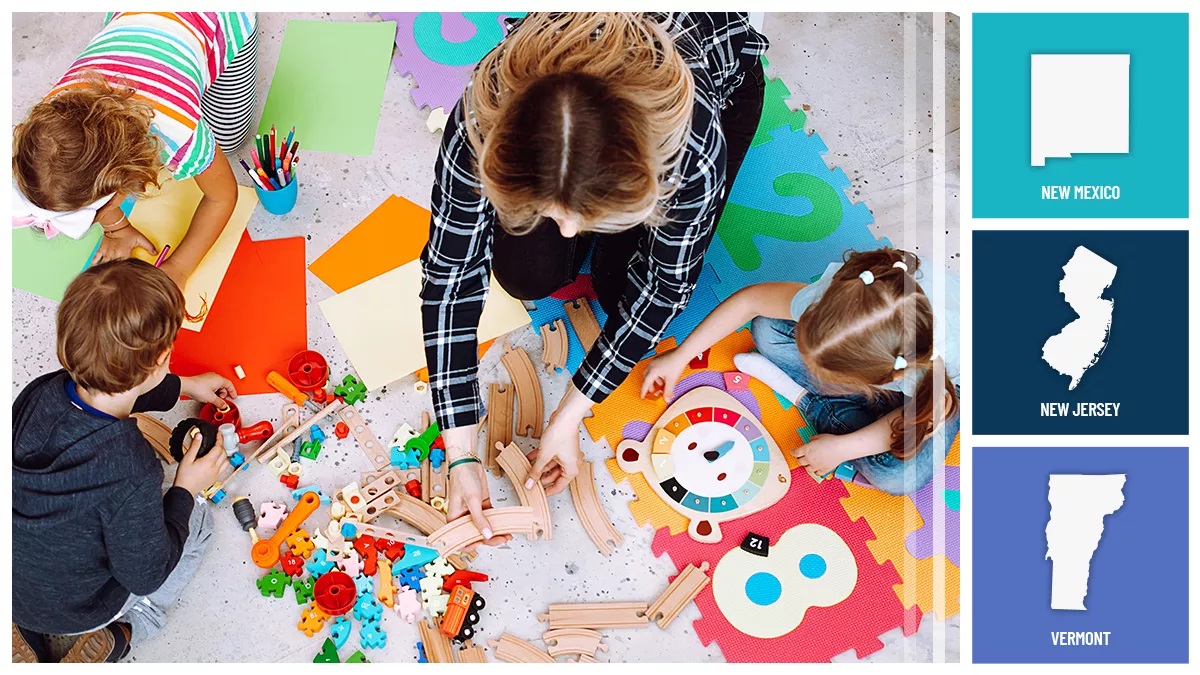👋 Welcome back to Starting Early — here’s to a healthy 2023. Every other week, we spotlight new reports, useful news, engaging interviews with people doing important work, and interesting takes on maternal health and early childhood development issues.
The US child care system is messy, hard to navigate, and expensive. It’s also in crisis — facing a shrinking workforce, with many facilities on the brink of shutting down.
In the absence of adequate federal action, such innovative state-based solutions as New Mexico’s Early Childhood Education and Care Fund, Vermont’s Let Grow Kids, and New Jersey’s paid family leave are creating systems that support families’ needs.
Read the links and go deeper.
1 big thing: the child care workforce crisis

Since February 2020, about 100,000 people have left their jobs in child care. While the pandemic worsened the situation, the US child care sector has been in crisis since the federal government decided against codifying universal child care in the 1970s.
Low wages and undervaluing a predominantly female workforce contribute to the current shrinkage of the child care workforce.
- Low wages: Full-time early childhood teachers average $14 an hour in pay. Target, Trader Joe’s, and Amazon warehouses pay more than most child care jobs. Compensation is so low that more than half of child care workers or their family members enroll in public support programs.
- Devaluing women’s work: Women make up nearly 97% of child care workers. Over a third are women of color – greater than their share of the US population. The notion that child care is “women’s work” diminishes pay and recognition. Child care work is perceived as lesser than K – 12 education, though the time from birth to age 5 is the most fundamental to a child’s development.
Families suffer: The critical loss of child care workers means fewer parents can get back to work.
- More than half of US families live in a “child care desert” — defined as any census tract with more than 50 children under 5 that has either no child care providers or so few that there are at least 3x as many children as there are child care slots.
- For many who can find child care, the cost is prohibitive. When families spend more than 7% of their income on child care, basic needs become unaffordable. Yet, low-income families spend about 30% of their income on child care and middle-income families spend 10-14%.
- The lack of child care and paid family leave keeps many women out of the workforce. During the first few months of 2020, more than 2 million women either left or were forced out of their jobs. Among the leading causes: a sudden lack of child care options.
The bottom line: Easy access to child care is critical to overall economic growth, women’s labor force participation, and helping parents get the support needed for families to thrive.
2. States lead the way

The child care workforce crisis requires immediate, comprehensive action. Without federal help when pandemic relief funds expire this year and next, the US could lose at least half of today’s licensed child care centers.
Ashley Beckner, a venture partner at Imaginable Futures, shares, “With stalled action at the federal level, states have led the way on passing and implementing family-friendly policies.”
And, as in such important areas as child labor laws and workers’ rights, state change often leads to federal action.
New Mexico: In 2021, Gov. Michelle Lujan Grisham declared a 2-year commitment to expand eligibility for New Mexico’s child care subsidy to 3.5 times the federal poverty line and increase payments to providers.
New Mexico voters overwhelmingly approved devoting a portion of the state’s Land Grand Permanent Fund — which comes from the state’s oil and gas revenue and interest on the fund’s investments — to early care and education.
- New Mexico’s Early Childhood Education and Care Fund, the first in the nation, raises entry-level child care workers’ pay to $15 an hour and allocates $150 million a year to early childhood education.
New Jersey: NJ is one of 11 states to provide parents and caregivers with partial wage replacement when they take off from work to care for family members.
- Bonding Time: Family Leave Insurance enables working people to bond with a newborn, newly-adopted or newly-placed foster child, or provide care for a seriously ill or injured loved one.
- Health and economic benefits: Paid leave is associated with better health and less stress– from decreased preterm births to increases in well-baby visits, breastfeeding, and attachment. Paid leave helps increase household income and reduce the likelihood that new mothers fall into poverty.
- More dads need to take part: Through social media outreach, state Labor Commissioner Robert Asaro-Angelo is trying to make sure expectant fathers and partners know they’re eligible for Family Leave Insurance. Today, 4 out of 5 NJ families could receive more paid time off than they sign up for.
Vermont: Child care advocacy is infused with thousands of parent voices from across the state through the leadership of Let’s Grow Kids.
- Clear goals: Executive Director Aly Richards explains, “The solution must include investment in significant and sustainable public resources so every child who needs it has access to quality child care, families spend no more than 10% of their income on child care, and early childhood educators are fairly compensated.”
- Businesses are getting on board: Vermont’s child care campaign enjoys strong backing from a fast-growing coalition of employers statewide who want a public financing mechanism for child care.
Advocacy is key: The philanthropy sector is in a critical position to support advocacy for state and local policies for high-quality child care and greater compensation for providers.
- Jessie Rasmussen, the president of the Buffett Early Childhood Fund, says: “While I believe many investors still think policy advocacy is ‘too political’ for foundations, more and more now see state-level policy advocacy as an essential component of a high-impact strategy. They’re seeing how funding the pursuit of permanent stable, state support leads to funding that will long outlast private donations to programs.”
3 questions with Dr. Dana Suskind: Building a parent nation

We had an illuminating conversation with Dr. Dana Suskind, pediatric cochlear implant surgeon and founder and co-director of the TMW Center for Early Learning + Public Health at the University of Chicago. Dr. Suskind’s desire to work on healthy child development stems from her time in the operating room and wanting to understand her patients’ different language development outcomes. This led her to write Parent Nation: Unlocking Every Child’s Potential, Fulfilling Society’s Promise.
Here are highlights from our conversation:
What are the “3Ts” and how do they promote nurturing adult-child interactions?
The 3Ts refers to Tune In, Talk More, and Take Turns. Tuning in means being in the moment and paying attention to what a child is focused on. Talk more means responding to a child’s interest by talking about it, using rich and varied language. And once parents tune in and talk more, they automatically do take turns and have conversations with their child, which is the key aspect of nurturing interactions and a catalyst for healthy brain development. During those first thousand days and beyond, like milk feeds the body, social nourishment feeds the brain. This results in the million new neural connections that happen every second.
What’s one big idea from Parent Nation?
We often hear from parents how understanding brain science allows them to comprehend their crucial role as brain architects, which strengthens their bond with their children. We can use this same neuroscience framework to support parents and caregivers in building children’s brains and in building a society that truly centers children and families. It’s not just that giving every child a chance is the morally right thing to do – which we, as a nation that professes to care about children and families, should commit to. It’s also good for us as a society.
Tell us about your idea for creating an “AARP for parents”
Older adults used to be the poorest segment of the population. They had the fewest resources, the least political power, and were the least politically involved. AARP galvanized this segment of the population and enabled them to see themselves as deserving of investment. Parents aren’t that different: Right now, they don’t feel deserving. We have convinced parents that raising children is a go-it-alone scenario, so they’re raising the next generation without the support that they need. We’ve got the economic case and the research case to develop better policies to help parents. What we don’t have is the public will. An AARP for parents could be the engine behind that movement.
4. The roundup
Learn about upcoming events, new funding opportunities, and jobs in maternal and infant health and early childhood:
- Reshma Saujani, founder/CEO of Moms First, and Tim Allen, CEO of com, were featured on a podcast about the pandemic’s impact on parents, working culture, and child care.
- Trenton Kids Count 2023 is launched! Learn more about how Trenton’s kids are doing here.
Join the New Jersey Health Care Quality Institute March 3 for an in-person discussion to advance their 2022 Maternity Action Plan (MAP). To attend, join one of 4 virtual work sessions on data collection, community-based social supports, the maternal-infant health workforce, and reforming program payment methods.
